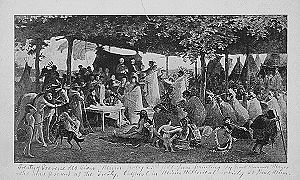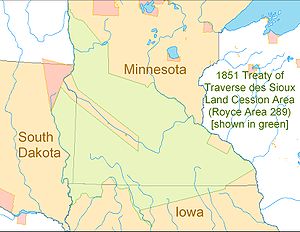
Treaty of Traverse des Sioux
Encyclopedia


United States
The United States of America is a federal constitutional republic comprising fifty states and a federal district...
government and Sioux
Sioux
The Sioux are Native American and First Nations people in North America. The term can refer to any ethnic group within the Great Sioux Nation or any of the nation's many language dialects...
Indian bands in Minnesota Territory
Minnesota Territory
The Territory of Minnesota was an organized incorporated territory of the United States that existed from March 3, 1849, until May 11, 1858, when the eastern portion of the territory was admitted to the Union as the State of Minnesota.-History:...
by which the Sioux ceded territory. The treaty was instigated by Alexander Ramsey
Alexander Ramsey
Alexander Ramsey was an American politician. He was born near Harrisburg, Pennsylvania.Alexander Ramsey was elected from Pennsylvania as a Whig to the U.S. House of Representatives and served in the 28th and 29th congresses from March 4, 1843 to March 4, 1847...
, the first governor of Minnesota Territory, and Luke Lea
Luke Lea
Luke Lea may refer to:* Luke Lea , U.S. Representative from Tennessee, 1833–1837* Luke Lea , U.S. Senator from Tennessee, 1911–1917; founder of The Tennessean newspaper* Luke Lea, Commissioner of Indian Affairs 1850-1853...
, Commissioner of Indian Affairs in Washington, D.C.
Washington, D.C.
Washington, D.C., formally the District of Columbia and commonly referred to as Washington, "the District", or simply D.C., is the capital of the United States. On July 16, 1790, the United States Congress approved the creation of a permanent national capital as permitted by the U.S. Constitution....
The United States wanted the treaty to gain control of agricultural lands for more settlers.
Background
The WahpetonSisseton Wahpeton Oyate
The Sisseton-Wahpeton Oyate of the Lake Traverse Reservation, formerly Sisseton-Wahpeton Sioux Tribe/Dakota Nation, is a federally recognized tribe comprising two bands and two sub-divisions of the Isanti or Santee Dakota people...
and Sisseton bands of the Upper Dakota (sometimes spelled Dahkotah on treaties) were hesitant to sign away so much land, but older members of the tribes believed that the results of the 1825 Treaty of Prairie du Chien
Treaty of Prairie du Chien
The Treaty of Prairie du Chien may refer to any of several treaties made and signed in Prairie du Chien, Wisconsin between the United States, representatives from the Sioux, Sac and Fox, Menominee, Ioway, Winnebago and the Anishinaabeg Native American peoples.-1825:The first treaty of Prairie du...
and the Sioux defeat in the Black Hawk War
Black Hawk War
The Black Hawk War was a brief conflict fought in 1832 between the United States and Native Americans headed by Black Hawk, a Sauk leader. The war erupted soon after Black Hawk and a group of Sauks, Meskwakis, and Kickapoos known as the "British Band" crossed the Mississippi River into the U.S....
limited their choices. The Wahpeton and Sisseton bands ceded their lands in southern and western Minnesota Territory, along with some lands in Iowa
Iowa
Iowa is a state located in the Midwestern United States, an area often referred to as the "American Heartland". It derives its name from the Ioway people, one of the many American Indian tribes that occupied the state at the time of European exploration. Iowa was a part of the French colony of New...
and Dakota Territory
Dakota Territory
The Territory of Dakota was an organized incorporated territory of the United States that existed from March 2, 1861, until November 2, 1889, when the final extent of the reduced territory was split and admitted to the Union as the states of North and South Dakota.The Dakota Territory consisted of...
. In exchange, the United States promised payment of $1,665,000 in cash and annuities. Through the Treaty of Traverse des Sioux and the Treaty of Mendota
Treaty of Mendota
The Treaty of Mendota was signed in Mendota, Minnesota on August 5, 1851 between the United States federal government and the Sioux tribes of Minnesota ....
, the Mdewakanton
Mdewakanton
Mdewakantonwan are one of the sub-tribes of the Isanti Dakota . Their historic home is Mille Lacs Lake in central Minnesota, which in the Dakota language was called mde wakan .As part of the Santee Sioux, their ancestors had migrated from the Southeast of the present-day United States, where the...
and Wahpekute bands of the Lower Sioux ceded territory of nearly 24 million acres (97,000 km²) of land. The US paid the Dakota an annuity the equivalent of 3 cents an acre, and charged settlers $1.25 an acre
The US set aside two reservations for the Sioux along the Minnesota River
Minnesota River
The Minnesota River is a tributary of the Mississippi River, approximately 332 miles long, in the U.S. state of Minnesota. It drains a watershed of nearly , in Minnesota and about in South Dakota and Iowa....
, each about 20 miles (32.2 km) wide and 70 miles (112.7 km) long, which later were made temporary.
The Upper Sioux Agency was established near Granite Falls, Minnesota
Granite Falls, Minnesota
As of the census of 2000, there were 3,070 people, 1,344 households, and 806 families residing in the city. The population density was 890.5 people per square mile . There were 1,472 housing units at an average density of 427.0 per square mile...
, while the Lower Sioux Agency was established about thirty miles downstream near Redwood Falls, Minnesota
Redwood Falls, Minnesota
As of the census of 2000, there were 5,459 people, 2,266 households, and 1,389 families residing in the city. The population density was 1,167.1 people per square mile . There were 2,377 housing units at an average density of 508.2 per square mile...
. The Upper Sioux were not satisfied with their reservation because of low food supplies, but as it included several of their old villages, they agreed to stay. The Lower Sioux were displaced from their traditional woodlands, and were dissatisfied with their territory. The Sioux resented the separate "trader's paper" that was included in the treaty, as it paid $400,000 of the promised treaty annuity total to fur traders and mixed-bloods who had financial claims against the tribes. Traders' papers were documents that contained the names of traders, included in the aforesaid claims, who were due fees from previous trades. It also stated that they were allowed to take in land currency what may have been owed them out of the Dakotas' treaty payments. The Dakota agreed to sign the treaty but also requested a copy. Upon signing the copy, they were asked to sign a third paper which they believed to be a third copy. The Dakota were tricked into signing these "trader's papers", as the interpreters had not accurately told them what the document meant.
Despite these issues, the crush of settlers moving into the area meant more European-American people encroaching on Sioux land. As the US had promised increased annuity payments in exchange for more land cessions, Chief Red Iron said, "the white settlers started Sioux leaders went to Washington, D.C. in 1858 to sign another pair of treaties; these ceded the reservation north of the Minnesota River.
The US intended the treaties to encourage the Sioux to convert from their nomadic hunting lifestyle into more European-American settled farming, offering them compensation in the transition. The forced change in lifestyle and the much lower than expected payments from the federal government caused economic suffering and increased social tensions within the tribes. Finally their resentments broke out in the Dakota War of 1862
Dakota War of 1862
The Dakota War of 1862, also known as the Sioux Uprising, was an armed conflict between the United States and several bands of the eastern Sioux. It began on August 17, 1862, along the Minnesota River in southwest Minnesota...
.
Terms
The preamble begins with,The abbrevaited terms of the treaty were:
1. Peace and friendship shall be perpetual
2. Land to cede
3. Stricken out.
4. Payments and other payments held in trust.
5. Laws against liquors in Indian country.
6. Rules and regulations to protect the rights of persons and property among the Indians.

